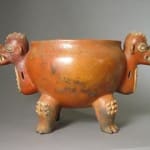Terracotta Bowl in the Form of a Double-Headed Animal, 300 BCE - 500 CE
Terracotta
11.5
PF.4090
Further images
With an increase in demand for pottery goods, especially among the upper classes that sought elaborate works, a vibrant era of ceramic creativity flourished. This not only meant an increase...
With an increase in demand for pottery goods, especially among the upper classes that sought elaborate works, a vibrant era of ceramic creativity flourished. This not only meant an increase in overall production, but more importantly, allowed artists the freedom to unleash their imagination and create works of art that have few parallels. Though adhering to functional needs of a large opened mouth container, suitable for holding a fairly sizable amount of grain or maize, this remarkable vessel is also a tangible example of Costa Rican mythology. The identical heads, which serve as handles, show a creature combining alligator and jaguar- both of which were regarded as sacred and much revered. The studs on the legs, neck and hair represent the scuds of the crocodile; its sharp teeth fiercely exposed are done in the same buff color, as are the eyes, which has the effect of making the most menacing aspects stand out from the deep orange background. The band of design around the lip unites the two figures into a single whole of perfect balance. It is possible this vessel was made specifically to hold special contents off limits to others. Perhaps a shaman's bowl for mixing potions or divining in water with the two creatures standing as sentinels. Whatever its function centuries ago, it retains its aura of mystery and magic, for new searchers of the unknown.









